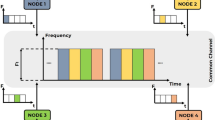Abstract
Mobile communications has witnessed an exponential increase in the amount of users, services and applications. WiMAX (Worldwide Interoperability for Microwave Access) targets to provide broadband connectivity to wide area coverage, both in fixed and in mobile environments, as well as in the provision of QoS constraints of those applications and services envisioned for Next Generation Networks (NGNs), which results in significant design challenges in the MAC (Medium Access Control) to provide the seamless transport of heterogeneous traffic in a cost-effective manner. This paper proposes a Dynamic Resource Allocation (DRA) architecture for the IEEE802.16e broadband wireless system (also known as Mobile WiMAX) that can provide operators the flexibility to deliver broadband traffic with high spectral efficiency. The proposed DRA architecture framework encompasses scheduler, Link Adaptation (LA), Resource Allocation (RA) and Hybrid Automated Repeat Request (HARQ) functional blocks which interwork seamlessly. The performance of the DRA was evaluated using commonly deployed scheduling policies: Max C/I, Proportional Fair and Round Robin schemes. Simulation results show that the proposed DRA scheme has the capacity to provide enhanced coverage and QoS provisioning for the area networks (WANs), such as the ones envisioned for B3G mobile wireless networks.












Similar content being viewed by others
References
ITU-R (2003) Vision, framework and overall objectives of the future development of IMT-2000 and systems beyond IMT-2000. draft new recommendation ITU-R M. [imt-vis] [doc. 8/110], Feb
Cimini LJ (1985) Analysis and simulation of a digital mobile channel using orthogonal frequency division multiplexing. IEEE Trans Comm COM 33(7):665–675 June doi:10.1109/TCOM.1985.1096357
Kwon T, Lee H, Choi S, Kim J, Cho D (2005) Design and implementation of a simulator based on a cross-layer protocol between MAC and PHY layers in a WiBro compatible IEEE 802.16e OFDMA System. IEEE Comm Mag :136–146, Dec doi:10.1109/MCOM.2005.1561931
Cimini LJ (2006) A tutorial on cross-layer optimization in wireless networks. IEEE J Sel Areas Comm 24(8):1452–1463 Aug doi:10.1109/JSAC.2006.879351
WiMAX forum, http://www.wimaxforum.org
IEEE Std 802.16-2004 (2004) IEEE standard for local and metropolitan area networks—Part 16: air interface for fixed broadband wireless access systems. Oct
IEEE802.16e (2005) [IEEE Std 802.16e, “Part 16: Air Interface for Fixed and Mobile Broadband Wireless Access Systems”, Dec
Yaghoobi H (2004) Scalable OFDMA physical layer in IEEE802.16. Intel Technol J 8(03), Aug
Mobile WiMAX—Part I: a technical overview and performance evaluation, Aug. 2006, WiMAX Forum
Balachandran K et al (2007) Design and analysis of an IEEE 802.16e-Based OFDMA communication system. Bell Labs Tech J 11(4):53–73 doi:10.1002/bltj.20196
Kwon T, Lee H, Choi S, Kim J, Cho D (2005) Design and implementation of a simulator based on a cross-layer protocol between MAC and PHY layers in a WiBro compatible IEEE 802.16e OFDMA System. IEEE Commun Mag :136–146, Dec doi:10.1109/MCOM.2005.1561931
Wang F, Ghosh A, Sankaran C, Fleming P (2006) WiMAX overview and system performance. IEEE VTC-2006, pp 1–5, Fall
Wang F, Ghosh A, Sankaran C, Benes S (2007) WiMAX system performance with multiple transmit and multiple receive antennas. IEEE VTC-2007 :2807–281, Spring
Hoymann C (2005) Analysis and performance evaluation of the OFDM-based metropolitan area network IEEE 802.16. Comput Networks 49(3):341–363 Oct
Liu P, Berry R, Honig ML (2003) Delay-sensitive packet scheduling in wireless networks. IEEE WCNC 3:1627–1632 Mar
Song G, Li Y (2003) Adaptive resource allocation based on utility optimization in OFDMA. Proc. IEEE GLOBECOM 2:586–590
ITU-R M.1225, 1997
Li Y, Huang X (2000) The generation of independent Rayleigh Faders. IEEE ICC 1:41–45 Jun
Xiandong et al (2003) A two-dimensional channel simulation model for shadowing processes. IEEE Trans Veh Technol 52(6), Nov
Fan Wang et al (2005) 3GPP TR IEEE802.16e System performance analysis and simulation results. Proc of PMIRC, Sept
TR 25.892 (2004) Feasibility study for OFDM for UTRAN enhancement. v1.1.0, Mar
Viswanath P, Tse D (2002) Opportunistic beamforming using dumb antennas. IEEE Trans Inform Theor 48(6), June
Jalali A et al (2000) Data throughput of CDMA-HDR—a high efficiency-high data rate personal communication wireless system. IEEE VTC 3:1854–1857 May
Author information
Authors and Affiliations
Corresponding author
Rights and permissions
About this article
Cite this article
Nascimento, A., Rodriguez, J., Mumtaz, S. et al. Dynamic Resource Allocation Architecture for IEEE802.16e: Design and Performance Analysis. Mobile Netw Appl 13, 385–397 (2008). https://doi.org/10.1007/s11036-008-0065-1
Received:
Accepted:
Published:
Issue Date:
DOI: https://doi.org/10.1007/s11036-008-0065-1




